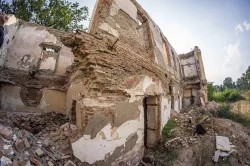Abafája

Abafája (Apalina) is in Transylvania, in Romania. It is famous for its Catholic church and for the stately house or castle of the Hungarian Huszár family. It is on the bank of the River Maros, six kilometers from the city of Szászrégen, on Saxon territory. Its name derives from the ancient Hungarian family name “Aba” and the word “fa” which stands for “forest”. It was mentioned first in 1332.

Initially, it used to be located a bit farther at a place called Beng but due to the Ottoman destruction, it moved to its present place. The settlement in the 15th century grew together with the village called Apáti, founded by the Abbey of Kolozsmonostor. Tompa Mihály was its owner in 1578, then it went to Abafáji Gyulai Pál in 1584. Abafáji Gyulai Pál (about 1550 – 1592) used to be vice-chancellor and secretariat of the Transylvanian prince, later an advisor. He had a great Renaissance education and had learned in Padua and Bologna.

When Prince Báthori István aka Stefan Batori gained the Polish throne in 1576, he took Gyulai with him to Poland who had made himself indispensable with his talent and skills. Gyulai’s favorite property was Abafája which he had received in 1584 from Prince Báthori István. Prince Báthori Zsigmond also granted him another land called Mocsár in 1591 which later became the favorite hunting forest of Prince Rákóczi I György. Unfortunately, Lord Gyulai Pál was executed by the prince in Abafája in 1592.

The famous Huszár Péter (1535-1603), formerly chief-captain of Pápa castle, the captain of Veszprém and Várpalota, the Bán (Duke) of Lugos, a soldier from the Trans-Danubian region of Royal Hungary, got the place from Prince Báthori Zsigmond of Transylvania in 1595. Huszár was renowned for his valiant deeds against the Ottomans. His descendant, Huszár Mátyás still had Abafája, he was the chief horseman and table master of Prince Rákóczi I György (1603-1648).
Mikes Kelemen (1690-1761) spent his childhood years in Abafája, too. He became the famous chronicler of Prince Rákóczi Ferenc. The castle has remained in the family’s hands from this time on. There is writing on the castle with the number “1590”, the building of the castle must have been earlier. (Note: I was intentionally using the Eastern name order as far as Hungarian names were concerned.)

The Huszár palace was built in the first part of the 19th century, in the late Baroque style. The palace was reconstructed at the end of the 19th century by Baron Huszár III Károly, it is the reason why we can see many romanticizing and eclectic elements. There were 32 rooms in the palace and an arched stone stable from the 18th century. There was a 30-acre-large park around the building, full of fountains, statues, exotic plants, and trees. After WWII, the rare trees were mostly cut off and used for heating. Currently, the original family managed to get the ruined building back and they are trying to sell it.

Here is a video of the building:
https://www.youtube.com/watch?v=s8WdNBuJMAw&t=9s
Check out the “Guardians of the Huszar palace” page:

https://www.facebook.com/huszarkastelyorzoi/
Dear Readers, I can only make this content available through small donations or by selling my books or T-shirts.
















